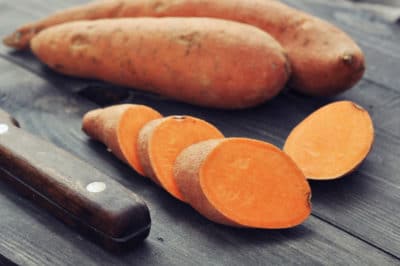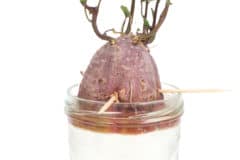How Growing Affects Storage
Properly grown sweet potatoes have the necessary nutrients and tissue moisture to store well. Sweet potatoes grow best in USDA Zones 8 through 11 as the long frost-free season and day length promote tuber development. They prefer a loose friable and slightly acid soil or moderate fertility – too much nitrogen encourages leaf rather than tuber growth. They will do better with regular water.
Varieties That Store Well
Almost all sweet potatoes will store for several months if properly grown, cured and stored. These are noted for longer storage qualities and may keep six months or more:
- All Purple
- Beauregard
- Bellevue
- Bellevue LA 06-52
- Burgundy LA 04-175
- Carolina
- Centennial
- Jewel.
Curing and Storage
Sweet potatoes must be cured properly to store well. When first harvested, the tubers are less sweet and the texture is dense. Curing helps heal minor wounds by fostering the development of a protective layer over the whole root. The tubers’ outer cells also produce a waxy coating called suberin that protects the tuber from insects and helps prevent excessive water loss.
Short-Term Storage
If you just want to store a few tubers in the kitchen for a week or two, you can place them in the pantry at normal room temperature. In a cool, dark area like a root cellar, they’ll usually be good for about a month. Extend storage life by using a loosely covered basket or bag with holes. Once you’ve cut the tuber, cover with cold water and refrigerate; use within 24 hours.
Long-Term Storage
Finding ideal storage conditions for sweet potatoes over the long term may take a bit of effort on your part. The ideal storage temperature is 55 to 60°F (13 to 6°C). Temperatures above 60°F (16°C) may cause the tuber to become pithy, shrink or be more susceptible to damage from viral diseases. Storage at temperatures under 55°F (13°C) may result in chilling injury. Humidity should be high – around 60 to 70%.
Freezing Sweet Potatoes
Freezing is one good way to keep sweet potatoes for long-term storage, no matter what the variety. Pureed tubers will do the best, as chunks and slices are more susceptible to freezer burn. Cook the potatoes, let cool and then package in your choice of container. Thaw and stir well before heating in the oven or on the stovetop.
Dehydrating Sweet Potatoes
Sweet potatoes can be dehydrated quite easily. Sliced thin, lightly brushed with coconut oil before dehydrating and then sprinkled with salt, they make a good stand-in for potato chips. Slightly thicker slices can be rehydrated with boiling water and used as a vegetable. Use a mandoline for even slices that will dry more quickly and evenly.
Canning Sweet Potatoes
Sweet potatoes can be pressure canned. They are usually cut in one-inch chunks for canning to ensure thorough cooking. Follow a tested recipe and make sure you follow it exactly, especially as regards processing times. Sweet potatoes are considered a low acid vegetable and should never be canned in a water bath. Canned sweet potatoes will be softer than regular cooked or baked sweet potatoes.
Preventing Sprouting
Once their dormancy requirements are met, sweet potatoes will start to sprout. This is a normal part of the reproductive process. Early sprouting, however, will shorten storage life. Excessively warm temperatures may hasten sprouting, especially in combination with higher humidity. If stored with apples or bananas, they may sprout early.
Storage Problems
Rodents like mice enjoy sweet potatoes just as much as people do; make sure your containers or the entire storage area are rodent-proof. If the humidity is too high, it may lead to mildew and rot. Always handle your sweet potatoes very gently in the field or storage, They bruise easily and once bruised can develop rot. Check your potatoes at least once a week and remove any that look like they have surface mold.
What Not to Do
Don’t store sweet potatoes in airtight containers, as they need at least one complete air change in the environment every day. Keep them away from hot air and direct sunlight. However, they don’t need to be stored in complete darkness like Irish potatoes. Avoid propane heaters or fruits like apples and cantaloupes – they produce ethylene gas, which can promote early sprouting.












